Mobile Learning: A Visit to Flitch Green Academy
Flitch Green Academy is somewhat unprepossessing – at least from the outside. But once you go through the door, it’s a different story.
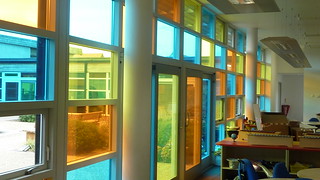 The hall windows give a great lighting effect as you walk inThe very first thing that strikes you about this small (around 210) rural mixed 4-11 school are the brightly coloured windows in the hall area. On a sunny day, especially, they definitely raise the spirits! But there’s more to the school than that.
The hall windows give a great lighting effect as you walk inThe very first thing that strikes you about this small (around 210) rural mixed 4-11 school are the brightly coloured windows in the hall area. On a sunny day, especially, they definitely raise the spirits! But there’s more to the school than that.
Although I visited Flitch Green to talk about technology – specifically, iPads and mobile learning – I discovered that as in any good school the technology serves the vision of the school, which is about learning. To be more specific, the school aims to engender and develop the following skills:
· Confidence
· Collaboration
· Critical thinking
· Creative navigation
· Overcoming challenges
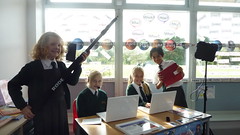 Some children work on their news presentation...It achieves this through challenges based on a home-grown scheme of work in which lots of subjects and skills are interweaved with each other through a central scenario. For instance, one of the projects involves investigating what has happened to a toy that has gone missing. The children are not even told which toy it was, and so they have to piece it all together from the descriptions given. That entails investigating different kinds of materials, creating a toy, and even comparing old and new toys – which in turn provides an opportunity for the children to quiz their parents and grandparents. The technology is brought into the picture as and when appropriate.
Some children work on their news presentation...It achieves this through challenges based on a home-grown scheme of work in which lots of subjects and skills are interweaved with each other through a central scenario. For instance, one of the projects involves investigating what has happened to a toy that has gone missing. The children are not even told which toy it was, and so they have to piece it all together from the descriptions given. That entails investigating different kinds of materials, creating a toy, and even comparing old and new toys – which in turn provides an opportunity for the children to quiz their parents and grandparents. The technology is brought into the picture as and when appropriate.
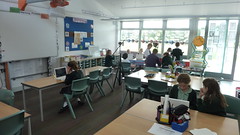 ... while others carry out researchSpeaking of which... Each teacher has been issued with a MacBook, and each classroom has access to 10 iPads and one MacBook between two pupils. As far as ‘apps’ are concerned, the teachers are encouraged to identify what they want the children to learn, and then select the apps accordingly. In other words, the education comes before the technology.
... while others carry out researchSpeaking of which... Each teacher has been issued with a MacBook, and each classroom has access to 10 iPads and one MacBook between two pupils. As far as ‘apps’ are concerned, the teachers are encouraged to identify what they want the children to learn, and then select the apps accordingly. In other words, the education comes before the technology.
The reason that the school went for a mobile technology approach was that, in the words of Nathan Lowe, the Acting Principal,
“We want to ensure that technology is used as a tool for learning and to allow children to use technology in their chosen learning spaces. We did not want a computer room, as in real life we don’t go to a special room to do our computer work!”
I saw the technology being used in various ways. For example, in the Reception class the children were using them to explore nursery rhymes. In Year 3, children investigating and recreating an Indian banquet did online research, created an animation and developed a music soundtrack using both recorded loops and original compositions. Year 4 children were making a television documentary, whilst the Year 5s were working on timeline of English monarchs using both film and music.
A few things struck me. First, all the children I spoke to seemed to be supremely confident and capable. So, was this evidence of the now discredited “digital native” idea? I asked them where they acquired their skills, and they all told me that they had learnt them earlier in their school career. So, it seems that the children were taught the skills in a way that was related to the work going on at the time, and not in a “Here is how you use the whole of iMovie” kind of way! I’ve always thought that teaching on a “need to know” basis – learning the skills you need when you need them – is the most sensible approach.
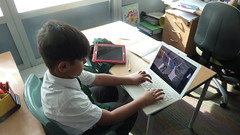 The children choose the most appropriate device for the work they are doing at the timeSecond, the children were allowed to select the technology they needed when they needed it, except where the teacher had set a non-ICT activity.
The children choose the most appropriate device for the work they are doing at the timeSecond, the children were allowed to select the technology they needed when they needed it, except where the teacher had set a non-ICT activity.
Third, as you will discover if you watch the short video interviews (see below), the children were highly articulate in what they had done using ICT – and those interviewees were fairly typical of all the pupils in that respect.
Fourth, the technology is being used to engage and motivate the children in interesting ways. For example, to overcome some pupils’ reluctance to do homework, their teacher, Emma Wildman, told them they could present it in whatever form they liked. Hence the video about solids, liquids and gases referred to in one of the interviews. Another example: everyone will tell you how hard it is to encourage boys to write. Emma has tackled this by getting them to make videos: doing so helps the boys structure their thoughts, which they can then channel into writing. No wonder that Emma told me that she can’t imagine being able to motivate and engage a whole class of pupils without this technology on hand!
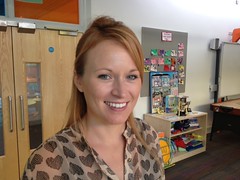 Teacher Emma WildmanFifth, although I was there for just a couple of hours, Flitch Green struck me as what I call a “thinking” or “learning” school. The Acting Principal, Nathan Lowe, told me how he has been influenced by the SAMR model, which posits the idea that technology can lead from enhancement to transformation. Also, the new Year 5 classroom will not have an interactive whiteboard: instead, having done a fair amount of research, Lowe has decided that a better approach would be to have a couple of ordinary whiteboards and a couple of Apple TVs, which will enable the pupils to very easily display their efforts on the screen without even having to move from their chair, let alone stretch to reach the whiteboard.
Teacher Emma WildmanFifth, although I was there for just a couple of hours, Flitch Green struck me as what I call a “thinking” or “learning” school. The Acting Principal, Nathan Lowe, told me how he has been influenced by the SAMR model, which posits the idea that technology can lead from enhancement to transformation. Also, the new Year 5 classroom will not have an interactive whiteboard: instead, having done a fair amount of research, Lowe has decided that a better approach would be to have a couple of ordinary whiteboards and a couple of Apple TVs, which will enable the pupils to very easily display their efforts on the screen without even having to move from their chair, let alone stretch to reach the whiteboard.
 Old and new technology is used as requiredThat the children are what might be called ‘active learners’, with the teacher often facilitating rather than didactically teaching, has been borne out by the school’s own lesson observations and pupil surveys as well as by visitors such as myself.
Old and new technology is used as requiredThat the children are what might be called ‘active learners’, with the teacher often facilitating rather than didactically teaching, has been borne out by the school’s own lesson observations and pupil surveys as well as by visitors such as myself.
Lowe’s vision is summed up, in his own words, thus:
“We want teachers and children to learn together with new technology, and for the children to see their teachers as learners too.”
Two children talk about their work...
For further information about the school, please visit http://theflitchgreenacademy.co.uk/ and http://www.apple.com/education/profiles/flitch-green
